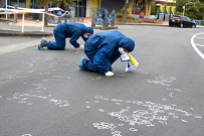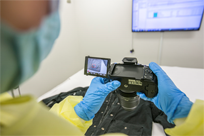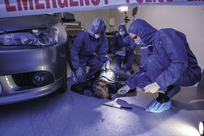ESR provides a range of basic and advanced training opportunities in bloodstain pattern analysis both in New Zealand and abroad. Whether you are a crime scene investigator, an instructor, a student, a laboratory-based scientist, or forensic consultant there will be something here for you.
These courses by themselves will not fully equip you to become a bloodstain pattern analyst; that will require many hours of mentoring, casework exposure and practice. However the material presented in these modules represents the underlying scientific theory and practice that is essential to any competent analyst. Find out more about the courses on offer below, or email Rosalyn Rough for more information: Rosalyn.Rough@esr.cri.nz.
 Basic level BPA training
Basic level BPA training
ESR provides residential-based basic BPA training at its Christchurch laboratory. The course is designed for technicians and scientists (as part of their training towards expert status in bloodstain pattern analysis), research students, and others who require an awareness of the science of BPA. The course is intended to develop a fundamental knowledge of the discipline of bloodstain pattern analysis and the ability to recognise basic pattern types as building blocks for complex patterns.
Advanced level BPA training
ESR provides residential-based advanced BPA training at its Christchurch laboratory. The course is designed for ESR scientists, research students and others who require advanced level instruction in the science of bloodstain pattern analysis. The course is intended to build on competencies gained during basic level training. The focus is on the recognition and interpretation of complex bloodstain patterns.
The fluid dynamics of bloodstain pattern formation
To assist bloodstain pattern analysts understand and articulate the science of bloodstain pattern formation, a 40 hour course entitled ‘The Fluid Dynamics of Bloodstain Pattern Formation’ has been developed. This course is designed to deliver advanced level training to experienced laboratory-based scientists, crime scene investigators and forensic consultants.
Participants on the course will develop an understanding of the principles of fluid dynamics as they apply to bloodstain pattern formation. The emphasis of this course will be on the relationship between the dynamics of bloodstain pattern formation and the characteristics of the resultant static bloodstain pattern. It will introduce participants to some of the basic concepts of fluid dynamics with particular reference to the behaviour of blood as a fluid. The course has a strong practical component with participants performing a number of experiments which will feature the use of a high speed digital camera.
High speed video library
The interpretation of bloodstain patterns at crime scenes and in the laboratory has to date relied extensively on the experience of the investigator. It is becoming increasingly important that this experience is complemented with a thorough knowledge of the fundamental mechanics of bloodstain pattern formation. As a contribution to this need, high speed video images of bloodstain pattern formation as well as a scientific explanation of the fluid mechanical process involved have been added to this site.
The video library contains video resources compiled during the completion of an MFRC/ESR funded project by Terry Laber, Bart Epstein and Michael Taylor in 2007 (Laber, T. L., et al. (2008). "High Speed Digital Video Analysis of Bloodstain Pattern Formation from Common Bloodletting Mechanisms." International Association of Bloodstain Pattern Analysts News 24(2): 4 - 12.). These resources are free to download from the MFRC website:
https://www.ameslab.gov/mfrc/bpa-videos(external link)
It is hoped that these resources will assist investigators, researchers, instructors, lawyers, and juries and in their task of understanding and interpreting bloodstain patterns for the administration of justice in jurisdictions around the world.

Criminology: Written in blood
A feature on Bloodstain Pattern Analysis with ESR's Michael Taylor

Forensic training
ESR provides training for forensic scientists, Police officers and investigators, and other law enforcement agencies.

